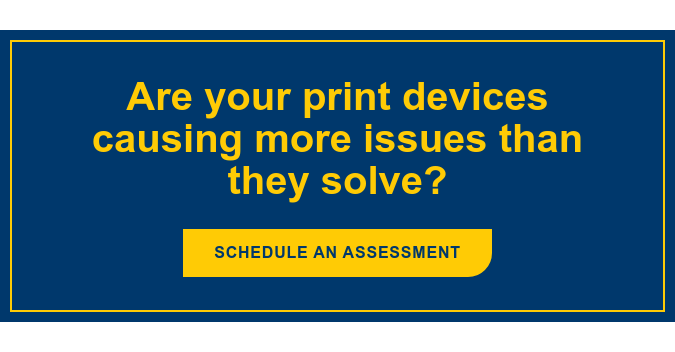 How often do you review your company’s print productivity, distribution and output? If you’re like most companies, you either don’t do it often or at all. But did you know that a thorough office equipment print assessment can save your organization 1-3% of your total annual revenue?
How often do you review your company’s print productivity, distribution and output? If you’re like most companies, you either don’t do it often or at all. But did you know that a thorough office equipment print assessment can save your organization 1-3% of your total annual revenue?
Here are the steps taken in a print assessment that will help you define which complete printing solution is right for your business. An experienced print services provider can assist you through this entire process.
1.) Itemizing Your Equipment Inventory
Documenting your current printer fleet is the first step. This information will help you analyze all the variables that affect printing costs and efficiency. The steps include:
- Counting the total number of inkjet printers, laser printers, copiers, multi-function devices, faxes and scanners located throughout your office
- Mapping their locations
- Documenting each device’s manufacturer, make and model
- Documenting each device’s age, network capability and connection
Additionally, consider the number of machines you have versus the number of employees in your organization. This ratio varies by industry but traditionally, most organizations find that they are providing one machine for every four employees. On average, we’ve determined that a more efficient ratio is one machine for every ten employees, but the right ratio for your business will depend on your specific print needs.
2.) Assessing Your Business Initiatives
A general review of your business initiatives and your print technology requirements will provide you with the information needed to identify improvements – and ultimately, opportunities to support your initiatives. A print provider can then recommend a solution designed to reduce or eliminate errors, improve print pace and uphold any necessary security measures your business may require.
3.) Reviewing Your Monthly Invoices
Monthly invoices related to service or repair, equipment and supplies (like paper, toner and print media) all contribute to an organization's overall cost or printing. Uncovering it all can be a tricky process as most organizations have multiple invoices with multiple vendors. But gathering this information is critical in helping you understand what’s being spent and how often. Your print provider will also uncover problem machines and recommend replacement options to better optimize your environment.
4.) Understanding Employee Burden Rates
Time is critically important to every employee supporting your organizations business goals. That’s why understanding how much time they might be spending managing your printer fleet is important. These are the tasks to track – per employee:
- Managing printer inventory
- Ordering supplies
- Fixing equipment malfunctions
- Scheduling ongoing or emergent service calls
- Processing monthly, quarterly or annual invoices
5.) Calculating Outsourced Print Costs
Are you outsourcing any print jobs? Why and how often? You might be outsourcing because your current equipment is inefficient or lacks the capabilities. Typically, outsourced jobs are more expensive. Your assessment might reveal technology solutions that will allow you to bring those jobs in-house and save money because of it.
This process may feel overwhelming, but when you consider the increase to your bottom line, it’s worth it. And, our technology advisors are here to help you assess these print expenses, identify what’s best for an organization of your size and need, and recommend a complete printing solution that will save you money.
